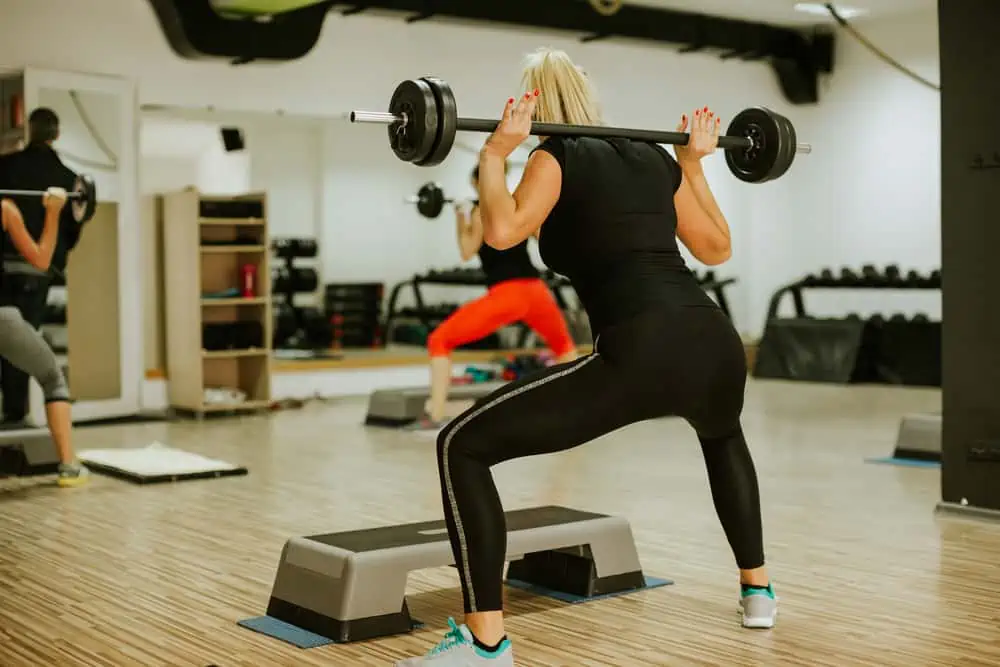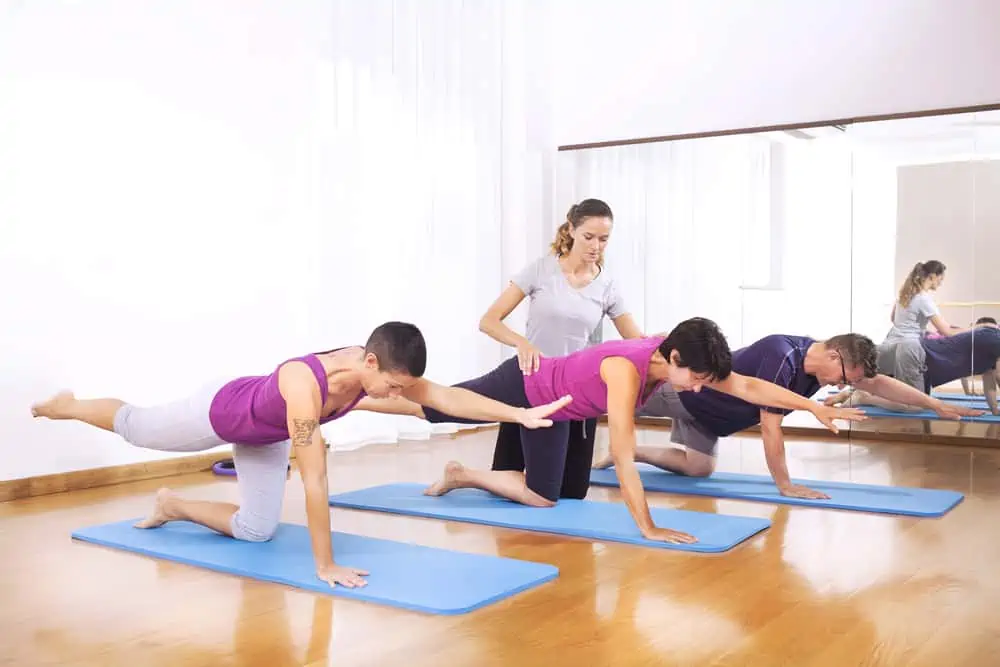This post may contain affiliate links. If you click through a link and make a purchase, I may receive a commission at no additional cost to you. As an Amazon Associate, I earn from qualifying purchases. Read the full disclosure here.
Running isn’t inherently bad for your body; however, sometimes you’re looking for a lighter alternative without compromising on heart rate boosting movement.
Low impact exercise decreases the stress on joints and soft tissues by eliminating jumping and other substantial forces on your body.
The benefits of low impact training include all the perks of regular exercise with less risk for joint pain and other musculoskeletal injuries.
It’s a common misconception that low impact workouts are also low intensity. But it’s entirely possible to get a great cardio workout with low impact.
Let’s explore eight low impact alternatives to running for a joint-friendly cardio boost.
Incline walking
If you like running, then walking doesn’t sound that exciting but hear me out. But adding hills or inclines can really boost your walk and get your heart rate up.
Even small inclines can increase your heart rate and engage your posterior chain (a fancy phrase for the back of the body).
Incline walking gives a boost to your glutes, hamstrings, and calves that need to work harder to push you up the hill.
If incline walking sounds boring, try an audio guided fitness walk by Aaptiv. Just follow the trainer’s cues and zone out to the music, and your workout will be done in no time! You can even get a free 30-day trial here!
Incline walking injury prevention tip
If you’re not used to inclines, pepper them in slowly to avoid overuse injuries such as Achilles tendonitis or plantar fasciitis.
Incline intervals are easy on a treadmill; for example, 1 minute of incline walking to 1 minute of flat walking. You can adjust the interval times and incline levels to your fitness needs and progress from there.
Elliptical
Ellipticals allow you to mimic a running motion with less impact. Adjustable resistance and incline further increase the challenge.
Elliptical machines vary from model to model, so if one doesn’t work for you, try different types. Subtle differences in angle and stride length make some machines more comfortable.
If your elliptical machine has moving arms, that’s an opportunity to get your upper body involved and boost your heart rate and calories.
If the elliptical sounds like a snooze-fest, try adding an Aaptiv guided elliptical workout to your routine. It’s guaranteed to give your workout a boost, and the best part is you don’t have to think about how many more minutes to drag yourself along. Just follow the trainer, and you’ll be done before you know it.
Elliptical trainer injury prevention tip
A common complaint with elliptical use is numbness in the toes. This is often due to constant pressure through the forefoot during the gait cycle.
Additionally, people often put all their weight in the forefoot instead of distributing it evenly through all points of the foot. This will also better engage the muscles of the posterior chain (backside) of the body.
For more ways to avoid toe numbness while using the elliptical read this article.
Indoor cycling
Have you ever tried a spin class? It’s not your average indoor cycle experience.
Spin classes are a fantastic low impact cardio alternative.
Spin bikes bring a sleek ride with the option to change resistance or stand and pedal. Ride up a “hill” while you’re still indoors.
Peloton is all the rage, but if you’re looking for a more affordable option, check out the Sunny Health & Fitness bike. You can use a smartphone or iPad to stream spin classes from the Peloton platform, Les Mills, or Aaptiv.
Indoor cycling injury prevention tip
Proper bike setup is important in maintaining good form and decreasing the risk of overuse injuries. Learn how to properly set up your bike here.
Don’t miss this article that outlines many common cycle class mistakes.
Low impact aerobics
Aerobics doesn’t get enough credit for its cardiovascular boost. Just the word “aerobics” seems to conjure up visions of big hair and colorful leotards.
In fact, most of the workouts on this list fall into the “aerobics” category.
During low impact workouts, one foot always maintains contact with the floor. Lighter movements like alternating single high knees and squats are swapped in for running and jumps.
Alternating sets of light cardio and weights are also a great option to add variety.
Check out some of the great options below!
Low impact aerobics injury prevention tip
Aerobics often involves pivoting and directional changes. Make sure you’re wearing proper footwear with good lateral support. I recommend cross training shoes over your average running shoe for aerobics.
This article reviews how to select the right footwear for your activities.
Nordic track classic pro skier
The only time I ever went cross-country skiing, I was super surprised at how much of a cardiovascular workout it was. The Nordic Track Classic Pro Skier lets you have the same cross-country ski cardio workout at home.
Once you get the rhythm of the reciprocal arm and leg motion, there’s no stopping your heart rate.
You can even adjust the elevation to simulate working up a hill. Trust me, this will get you breathing heavy.
You won’t find this equipment in most gyms, but it’s pretty lightweight as far as home cardio equipment goes.
Check out Nordic Track Classic Pro Skier here!
Nordic Track injury prevention tip
The Nordic Track Classic Pro Skier is adjustable for many different heights, so make sure you adjust the waist pad and handles a comfortable height/distance for your height.
Step aerobics
Step aerobics is high on intensity and low on impact. I won’t lie, step aerobics can be intimidating, and there is more of a learning curve, so temper your expectations.
Once you catch on, you’re in for a calorie-torching session.
Step aerobics is highly choreographed to the beat of the music. If you can mark time, you can do step.
Step and weight interval classes are also a great option for a high-calorie exercise session.
If you don’t have access to live step classes in your area, there are plenty of great online options to start this high cardio exercise at home. All you need is a step.
Check out C Dorner Fitness on YouTube for all your at-home step aerobics needs. No worries if you’re a complete beginner, she has options for you to learn step.
Step aerobics injury prevention tip
Don’t add a ton of risers underneath your step. This may sound counterintuitive, but you need to be able to move around the step quickly.
Zero to one set of risers is more than enough. Two risers can be used if you’re very tall or very advanced, however, this extra height is likely to get in the way for many.
Don’t miss Step Aerobics For Beginners – A Complete Guide To Getting Started.
Stair climber
Want to get your heart rate up in a hurry? Stairclimbers are the way to go.
This piece of equipment packs a punch when it comes to low impact cardio exercise, which is why there’s stiff competition for these machines at most gyms nowadays.
You’ll typically see two kinds: a more massive machine that looks like a rolling staircase, and a smaller one people might refer to as a “stepper.” Both are fine. It just depends on what you like.
The rolling staircase tends to get your heart rate up faster, however, the stepper option may be more comfortable for someone with a lower-body injury because you can limit your range of motion.
Stairclimber injury prevention tip
Don’t get too fancy with kicks, spins, and side steps. Straight-up climbing is one of the easiest ways to raise your heart rate.
To read more about the most common mistakes people make on a stair climber, read this article.
Nordic walking
Hiking can get as intense as you’d like it to be, depending on the trail and terrain.
Nordic walking is walking with the use of hand-held poles, and is a total body workout in disguise.
One study comparing Nordic walking with regular walking noted an average heart rate increase of 8.4% (with the highest being a 33 bpm increase) when walking at normal speeds.
Calorie burn was measured up to 45% higher with the use of walking poles. Hills add an additional challenge.
Walking poles can also be useful for additional balance on uneven terrain.
Nordic walking injury prevention tip
Nordic walking is relatively safe as compared to other activities, however you can help avoid annoying overuse injuries in the upper extremities by monitoring your grip and taking breaks to stretch the hands and forearms.
Low impact strength training
It might sound counterintuitive, but strength training that includes compound movements (multiple joints and muscles, for example, a squat with an overhead press) can increase your heart rate and provide cardiovascular exercise benefits.
Smaller, more isolated strength movements, while beneficial for muscle strength, don’t carry the same cardiovascular benefit.
Strength training injury prevention tip
Though compound movements boost your cardio, it’s easy to get carried away and let your form go by the wayside. Be sure to check your form and move slowly and with control to reap the benefits and avoid injury.
Wrapping up
Aerobic exercise is an important component for meeting your physical activity goals. Not only does it aid in weight loss, but also helps to keep your heart healthy.
Low impact doesn’t mean low intensity and is a great alternative. Try these low impact cardio workouts for a big heart rate boost that’s easier on your body.






